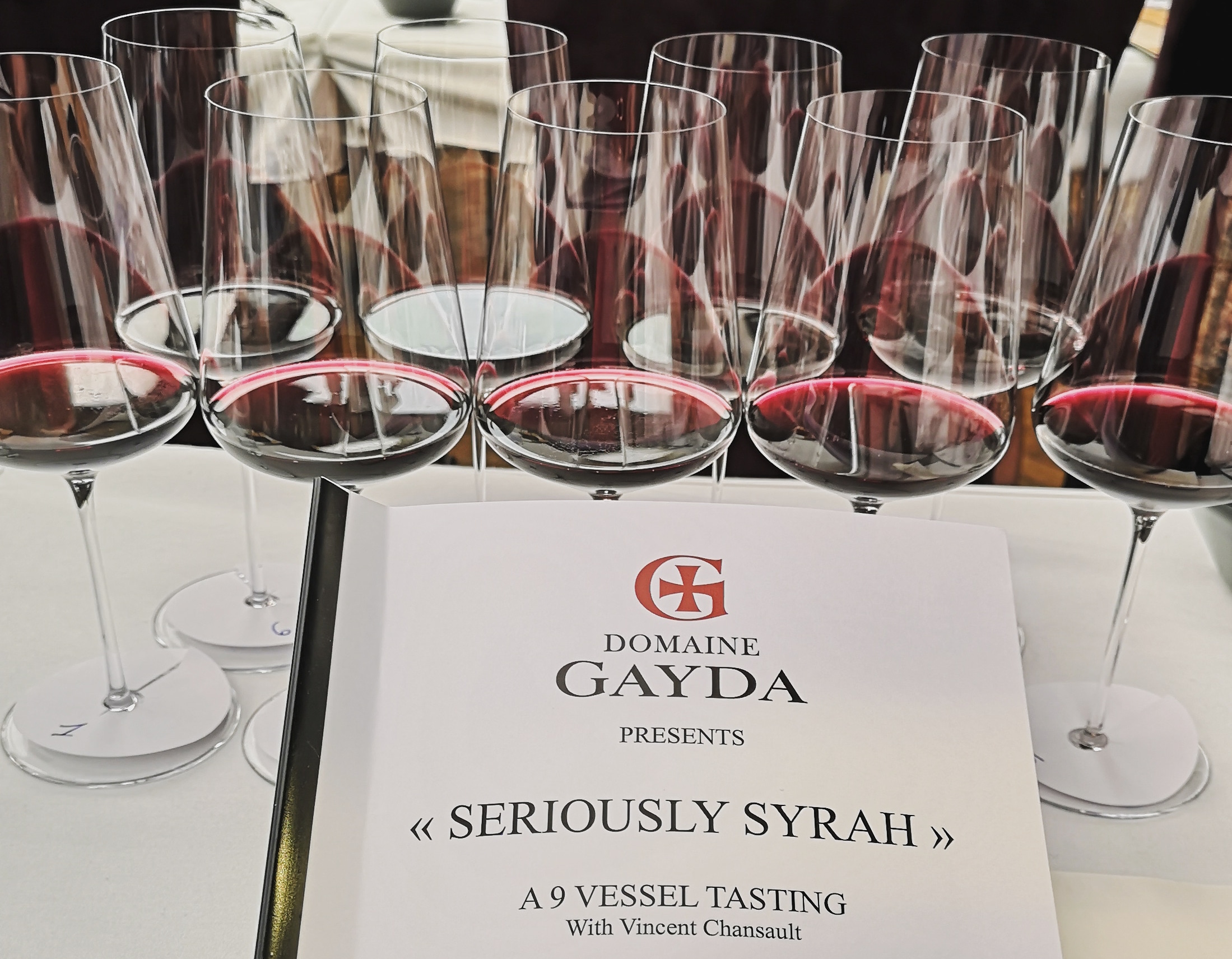The world of wine is changing so quickly, people like us need to do our best to keep up. With this in mind, the three of us were intrigued to attend a tasting held last week by award-winning Languedoc winery Domaine Gayda and their importer, New Generation.
This fascinating tasting showcased the dramatically different effects that vessels used to age wine can have on its flavour and texture. Why is this important? These days, most consumers are looking for wines that can be opened straight away rather than laying them down to age for years, so winemakers from regions with traditionally heavier red blends such as the Languedoc have had to revise their techniques. Forward-thinking Gayda have been experimenting extensively since 2012 to see which methods produce the most delicious wines that can be drunk straight away. Here’s what they trailed and what we found.
The vineyards at Domain Gayda. Credit: www.gaydavineyards.com
Same grape, vineyard, vintage and fermentation
To do this experiment, the domaine took exactly the same wine (100% Syrah from 30 year old vines in the south-east facing, Col de la Dona vineyard in Roussillon, harvested by hand and fermented in stainless steel) before transferring it into nine different vessels and left for nine months. Here’s what they used and the effects we tasted on the wine in practice:
Stainless Steel Tank (1500 litres)
Considered to be the benchmark for a neutral sample. Result expected: Clean, bright fruit and lean texture.
Terracotta Egg (700 litres)
The most amount of oxygen exchange expected due to porosity of the material. Egg shape allows for most amount of liquid and lees movement. Result expected: a more oxidative style with overripe fruit and juicy texture.
Concrete Egg (1600 litres)
Inert and cool with little oxygen exchange. Egg shape allows for most amount of liquid and lees movement. Result expected: Freshness, minerality and aromatics.
Plastic Egg (High density polyethylene egg - 1000 litres)
Plastic but with oxygen exchange to mimic a new oak oak barrel (17 mg/l per year oxygen transmission). Liquid and lees movement. Result expected: Freshness and aromatics with perhaps a wider, more lush texture from the extra oxygen.
Oak Foudre (v large barrel -2000 litres)
Oxygen exchange and a good amount of lees and liquid movement allowed. Result expected: ripest fruit with noticeably creamy texture.
Oak Barrel 500 litre (1 year old)
Half the size of a foudre and quite new, with some movement of liquid and lees. Result expected: subtle oak flavour and marked tannic structure with some creaminess from oxygen exchange.
Oak Barrel 228 litre (1 year old)
Half the size again and quite new, with some movement of liquid and lees. Result expected: more noticable oak flavour and heavier tannic structure.
Oak Barrel 228 litre (3 years old)
As above but after two more years of use. Result expected: less oak influence in terms of flavour, but a creamy structure because of the oxygen exchange.
Sandstone Jar
The material and shape of this jar allows for the least amount of oxygen exchange and movement of liquid and lees. Result expected: reduced flavours (a bit stinky and sulphurous), savoury notes and less fruit.
Conclusions
The differences were clear, but there we certainly some surprises. The most perfumed, pretty aromatics came from the eggs, especially the plastic one with its oxygen exchange system. The large oak barrel gave a wine that felt it had developed too early; that was overripe and lush, but would probably not go on much longer. The traditional stainless steel felt less fresh and round in comparison to the eggs, highlighting that these new vessels really do have a great place and purpose in modern winemaking. The more classic vessels - the smaller oak barrels -gave the most classic result of slightly spiced, textural wines with open, ripe fruit, but they still felt that they would be best tasted after a bit more time.
All in all, this was an incredibly interesting experiment that made most people in the room rethink their preconceptions about which materials do what to wine. It’s worth noting however that this was a big, ballsy Syrah and the results will be slightly different with other grape varieties. It’s all about choosing your vessel according to desired style. As Gayda winemaker Vincent Chansault says, it’s just like pots and pans for cooking. You chose one over another to add a certain nuance to your dish. With wine, it’s just the same.
Taste the Syrah
Domaine Gayda Cepages Syrah, RRP £8 - 10 from Cambridge Wine Merchants
No 1 Syrah, Domaine Gayda RRP £78 for 6 from ChapelDown.com
Syrah plays a large part in Gayda’s top wine: Chemin de Moscou
Try Chemin de Moscou 2015 RRP £29.95 from Amazon
See more about Domaine Gayda
See more about New Generation Wines
By Helena Nicklin


